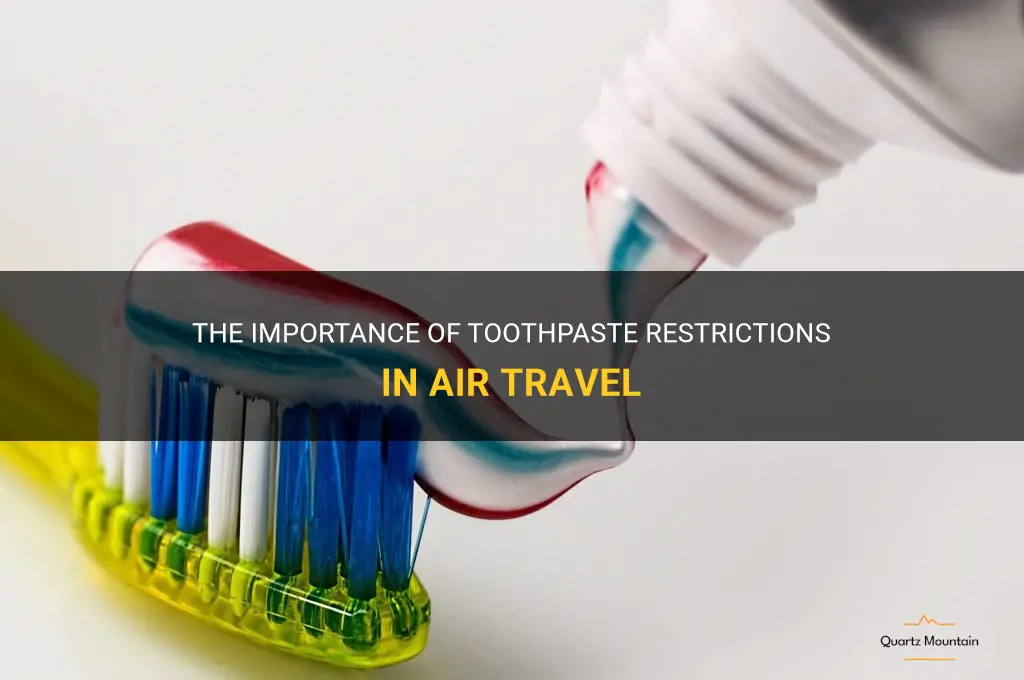
Air travel has become an essential method of transportation for millions of people around the world. From business trips to vacations, flying allows us to quickly and conveniently reach our destinations. However, there are various restrictions and regulations in place to ensure the safety of all passengers on board. One of these regulations includes restrictions on carrying liquids and gels, including toothpaste, in our carry-on luggage. This might seem like a minor inconvenience, but it serves a crucial purpose in maintaining the security of our flights. In this article, we will explore the reasons behind toothpaste restrictions on air travel and how we can navigate through them.
| Characteristics | Values |
|---|---|
| Container Size Limit | 100 ml or 3.4 oz |
| Carry-on Restrictions | Yes |
| Checked Restrictions | No |
| Packaging Requirement | Must meet TSA guidelines |
What You'll Learn
- Are there any specific restrictions on toothpaste when traveling by air?
- How much toothpaste can you bring on a plane?
- What is the maximum size tube of toothpaste allowed in carry-on luggage?
- Are there any restrictions on the type of toothpaste, such as gels or powders?
- Do toothpaste restrictions also apply to checked baggage on flights?

Are there any specific restrictions on toothpaste when traveling by air?
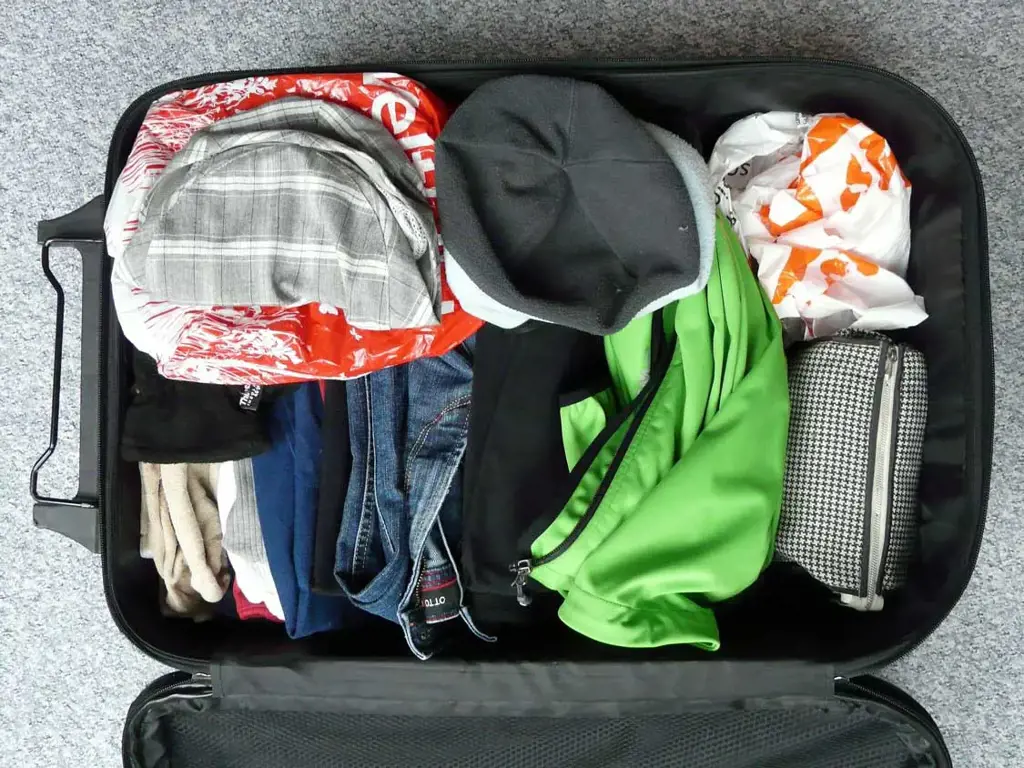
Traveling by air can be exciting and convenient, but it also comes with its fair share of restrictions. One common question that travelers often ask is whether there are any specific restrictions on toothpaste when flying. The answer is yes, there are certain rules and regulations regarding toothpaste and other liquids when it comes to air travel.
The Transportation Security Administration (TSA), which is responsible for security at airports in the United States, has implemented strict guidelines for carrying liquids on board an aircraft. These guidelines are in place to ensure the safety of passengers and crew members.
According to the TSA's rules, all liquids, gels, creams, and aerosols must be in containers that are 3.4 ounces or less. These containers must be placed in a clear, quart-sized, plastic bag and presented separately during the security screening process. This includes toothpaste and other oral hygiene products.
Additionally, each passenger is limited to one quart-sized bag of liquids. This means that if you have multiple containers of toothpaste, they must all fit within the quart-sized bag. If you have more containers than can fit in the bag, you will need to either leave them behind, transfer them to checked baggage, or purchase travel-sized versions that meet the size restrictions.
It's important to note that these rules apply to both carry-on and checked baggage. If you plan on taking toothpaste in your checked luggage, it is still subject to the 3.4-ounce limitation and must be securely packed to prevent leaks or spills.
Some travelers may wonder why there are such specific restrictions on toothpaste and other liquids. The reason is that these restrictions help airport security officers quickly and efficiently screen liquids for potential threats. By limiting the size of containers and requiring them to be placed in a separate bag, security officers can easily identify and inspect these items without causing unnecessary delays for travelers.
While it may seem inconvenient to follow these rules when it comes to toothpaste, it's important to remember that they are in place for everyone's safety. By adhering to these guidelines, you can help ensure a smooth and efficient screening process at the airport.
In conclusion, there are specific restrictions on toothpaste and other liquids when traveling by air. The TSA requires all liquids to be in containers that are 3.4 ounces or less and placed in a clear, quart-sized, plastic bag. Each passenger is limited to one quart-sized bag of liquids. These rules apply to both carry-on and checked baggage. By following these guidelines, you can help keep the airport security process running smoothly and ensure a safe and secure flight.
Navigating California's Lockdown: Understanding the Latest Travel Restrictions
You may want to see also

How much toothpaste can you bring on a plane?
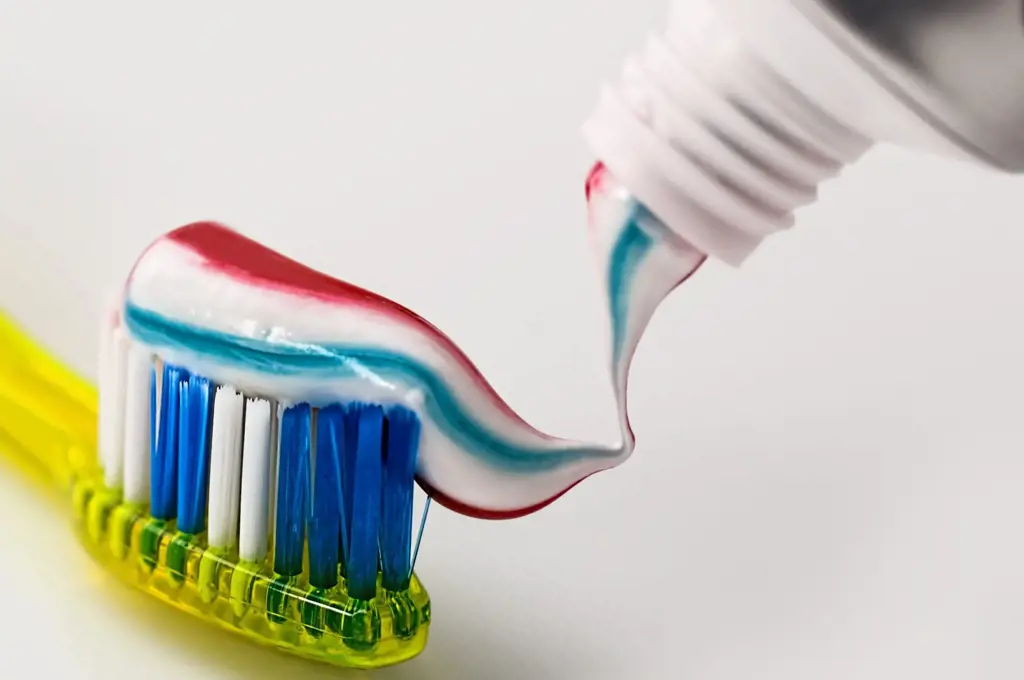
There are strict regulations regarding what you can bring when traveling on an airplane, and this includes toiletries such as toothpaste. It is important to be aware of these regulations to prevent any issues at airport security. So, how much toothpaste can you bring on a plane?
The Transportation Security Administration (TSA) has specific guidelines for carrying liquids, gels, and aerosols in your carry-on luggage. These rules are in place to ensure the safety of all passengers.
According to the TSA's 3-1-1 rule, you are allowed to carry a quart-sized bag filled with 3.4-ounce (100-milliliter) containers of liquids, gels, and aerosols. This includes toothpaste. The bag must be transparent and resealable. It is important to note that you are only allowed one quart-sized bag per passenger.
If you have a larger tube of toothpaste, you may be required to pack it in your checked luggage instead of your carry-on. Checked luggage has fewer restrictions when it comes to liquids, but it is still important to follow the guidelines set by the airline and the TSA.
It is worth considering purchasing travel-sized toothpaste tubes that meet the 3.4-ounce limit. This way, you can easily pack your toothpaste in your carry-on and avoid any potential issues at security. Many stores sell travel-sized toiletries specifically designed to meet airline regulations.
It's also important to be mindful of the toothpaste consistency. Some toothpastes have gel-like or liquid-like consistencies that may be subject to the same rules as liquids and gels. Make sure to check the consistency of your toothpaste and pack it accordingly.
To avoid any confusion or delays at security, it is always best to familiarize yourself with the regulations of the specific airline you are flying with. Some airlines may have stricter rules regarding liquids in carry-on luggage.
In conclusion, you are allowed to bring toothpaste on a plane, but it must be in a container that is 3.4 ounces or less. The toothpaste must be packed in a quart-sized, transparent, resealable bag. If you have a larger tube of toothpaste, it may need to be packed in your checked luggage. It's always a good idea to purchase travel-sized toothpaste tubes that meet the 3.4-ounce limit to avoid any issues at airport security. Following these guidelines will ensure a smooth and hassle-free experience when traveling with toothpaste.
Navigating Cook Islands Travel Restrictions: What You Need to Know
You may want to see also

What is the maximum size tube of toothpaste allowed in carry-on luggage?
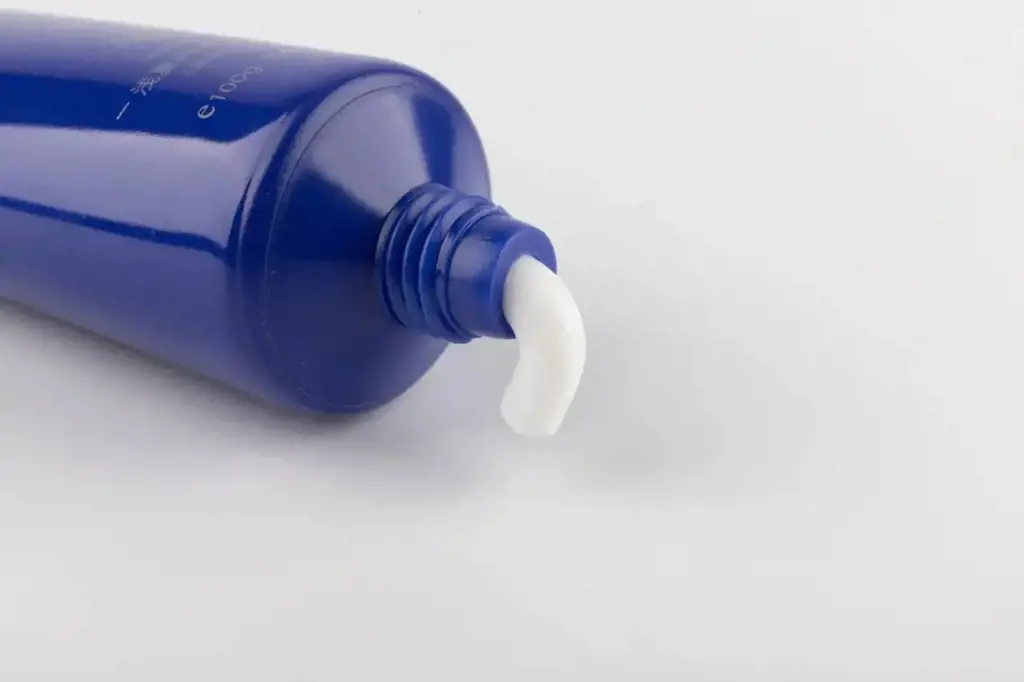
When it comes to packing carry-on luggage, there are numerous rules and regulations in place to ensure the safety and security of all passengers. One common question that travelers have is regarding the maximum size tube of toothpaste allowed in carry-on luggage.
The Transportation Security Administration (TSA) has set specific guidelines for carrying liquids, gels, and aerosols in carry-on bags. These guidelines apply to toothpaste as well. According to the TSA, passengers are allowed to carry liquids, gels, and aerosols in containers that are 3.4 ounces (100 milliliters) or less per item. These containers must be placed in a clear, quart-sized bag. Each passenger is limited to one quart-sized bag of liquids, gels, and aerosols.
So, when it comes to toothpaste, the maximum size tube that is allowed in carry-on luggage is 3.4 ounces (100 milliliters). This size restriction is in place to ensure that all liquids and gels can be easily screened by security personnel at the airport.
It is important to note that if you have a larger tube of toothpaste that exceeds the 3.4-ounce limit, it will have to be packed in your checked luggage instead of your carry-on bag. Checked bags have different regulations and limitations when it comes to liquids and gels, so it is essential to check with the airline or TSA website for the most up-to-date information.
Toothpaste is one of the essential items that many passengers like to have with them during their travels. It is always a good idea to check the size of your toothpaste tube before packing it in your carry-on bag to avoid any potential issues at the security checkpoint.
If you are unsure about the size of your toothpaste tube or any other liquid or gel product, it is recommended to transfer the contents to a smaller travel-sized container that meets the TSA guidelines. This way, you can ensure that you are following all the rules and regulations and avoid any unnecessary delays or confiscations at the security checkpoint.
In conclusion, the maximum size tube of toothpaste allowed in carry-on luggage is 3.4 ounces (100 milliliters). It is crucial to pack the toothpaste tube in a clear, quart-sized bag along with other liquids, gels, and aerosols. If you have a larger tube, it will need to be packed in your checked luggage instead. Following these guidelines will help make your travel experience smoother and more efficient.
Teton County Implements Travel Restrictions to Preserve Natural Beauty
You may want to see also

Are there any restrictions on the type of toothpaste, such as gels or powders?
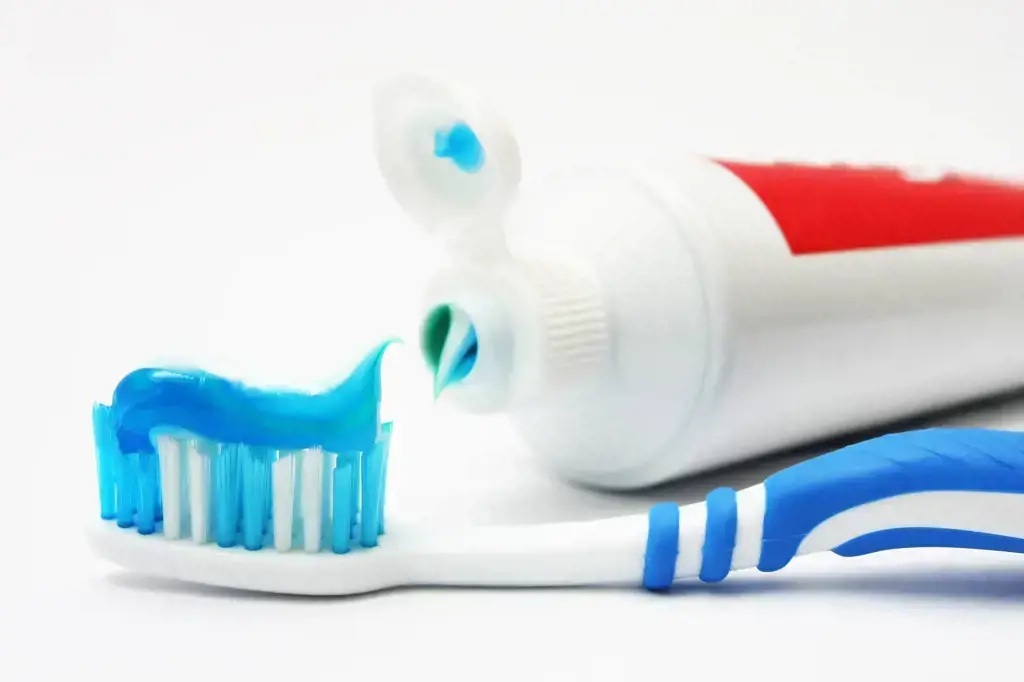
Toothpaste is an essential part of our daily oral hygiene routine, helping to remove plaque, prevent tooth decay, and freshen our breath. However, with so many types of toothpaste available on the market today, you may be wondering if there are any restrictions on the type of toothpaste you should use. Specifically, you might be curious about gels and powders and whether they are suitable alternatives to traditional toothpaste.
The good news is that there are no strict restrictions on the type of toothpaste you can use. Both gels and powders can be effective in maintaining good oral health, as long as they contain the necessary active ingredients. The key is to look for toothpaste that carries the American Dental Association (ADA) seal of approval. This seal guarantees that the toothpaste has been tested and proven to be safe and effective for use.
Gels are a popular choice for many people due to their smooth texture and ease of use. They are typically more viscous than traditional toothpaste and often come in attractive flavors. Gels contain similar active ingredients as regular toothpaste, such as fluoride, which helps strengthen tooth enamel and prevent cavities. Some gels may also contain desensitizing agents to alleviate tooth sensitivity or antibacterial agents to fight gum disease.
Powder toothpaste, on the other hand, has gained popularity in recent years as a natural alternative to traditional toothpaste. These powders often contain ingredients like baking soda, which has long been used as a cleaning agent due to its abrasive nature. Baking soda can help remove surface stains on teeth and freshen breath. Like gels, powder toothpaste should also contain fluoride to effectively protect against tooth decay.
In terms of effectiveness, studies have shown that both gels and powders can effectively clean teeth when used correctly. The most important factor in oral hygiene is brushing technique and frequency rather than the type of toothpaste used. It is recommended to brush your teeth at least twice a day for two minutes each time, regardless of whether you are using gel, powder, or traditional toothpaste.
Ultimately, the choice between gels, powders, or traditional toothpaste comes down to personal preference. Some people may prefer the texture and flavor of gels, while others may enjoy the natural and eco-friendly aspects of powder toothpaste. As long as the toothpaste has the ADA seal of approval and contains the necessary active ingredients, you can confidently choose the type that suits your needs and preferences.
It's important to note that if you have specific dental concerns, such as tooth sensitivity or gum disease, it is always best to consult with your dentist. They can provide personalized recommendations on the type of toothpaste that will be most beneficial for your oral health.
In conclusion, there are no strict restrictions on the type of toothpaste you can use. Both gels and powders can be effective in maintaining good oral hygiene as long as they contain the necessary active ingredients. The key to choosing the right toothpaste is to look for the ADA seal of approval and consider your personal preferences. Remember, proper brushing technique and frequency are more important than the type of toothpaste used. So, be sure to brush your teeth at least twice a day for two minutes each time, and don't forget to visit your dentist regularly for professional cleanings and check-ups.
Exploring the Travel Restrictions in Puerto Escondido: What You Need to Know
You may want to see also

Do toothpaste restrictions also apply to checked baggage on flights?
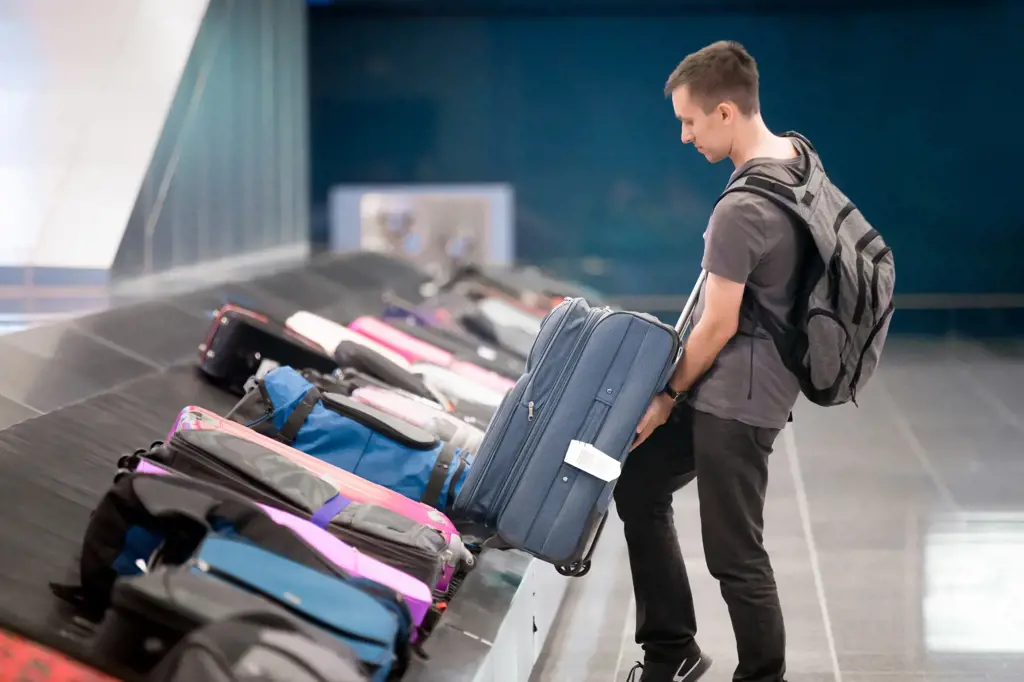
When it comes to flying, there are a number of restrictions and regulations in place to ensure the safety of passengers and crew. One common question that often arises is whether toothpaste restrictions also apply to checked baggage on flights. The answer to this question is somewhat complex, as it can vary depending on the specific airline and country you are flying with.
In general, liquid restrictions do apply to both carry-on and checked baggage. The Transportation Security Administration (TSA) in the United States has strict guidelines in place for liquids in both types of luggage. According to their regulations, any liquids, gels, and aerosols must be in containers that are 3.4 ounces (100 milliliters) or less and all containers must fit into a clear, quart-sized zip-top bag. This applies to toothpaste as well, so if your toothpaste is larger than 3.4 ounces, you will not be able to bring it in your carry-on luggage.
When it comes to checked baggage, the restrictions are a bit more lenient. In most cases, you are allowed to bring larger quantities of liquids, gels, and aerosols in your checked baggage. However, it's important to note that this can vary depending on the specific airline and country you are flying with. Some airlines may have additional restrictions in place, so it's always best to check with your airline before traveling.
For example, the European Union has a similar rule in place that allows passengers to bring liquids in containers larger than 3.4 ounces in their checked baggage. However, there is a maximum limit of 1 liter per passenger, and all containers must be placed in a resealable plastic bag. It's also worth noting that if you are flying to or from the United States, you will still need to comply with the TSA's regulations for liquids in your carry-on baggage.
In addition to size restrictions, it's important to consider the safety of your toothpaste when traveling. Toothpaste typically contains a variety of ingredients, including fluoride, which can be potentially hazardous if ingested in large quantities. For this reason, it's recommended to pack your toothpaste in a plastic bag to prevent any leaks or spills in your luggage. This will not only help protect your other belongings, but also make it easier for security officers to inspect your luggage if necessary.
In summary, toothpaste restrictions do generally apply to both carry-on and checked baggage on flights. However, the restrictions for checked baggage are typically more lenient, allowing you to bring larger quantities of toothpaste. It's important to check with your airline and country's specific regulations to ensure compliance and to pack your toothpaste securely to prevent any leaks or spills. By following these guidelines, you can ensure a smooth and hassle-free travel experience. So next time you're packing for a flight, be sure to double-check the regulations regarding toothpaste to avoid any last-minute surprises at the airport.
Navigating Orange Zone Travel Restrictions: What You Need to Know
You may want to see also
Frequently asked questions
Yes, you are allowed to bring toothpaste in your carry-on bag when traveling by air. However, there are restrictions on the amount of toothpaste you can bring. The Transportation Security Administration (TSA) allows each passenger to bring a 3.4-ounce (100-milliliter) container of toothpaste in their carry-on bag.
Yes, when going through airport security, you are required to place your toothpaste, along with other liquids and gels, in a clear, quart-sized plastic bag. Each item in the bag must be in a container of 3.4 ounces or less. This allows the TSA officers to easily inspect the contents of your bag.
Yes, you can bring a full-sized tube of toothpaste in your checked luggage. There are no restrictions on the size of toothpaste in checked bags. However, it is always a good idea to securely pack any liquids or gels to prevent leakage during transit.







